Starting from a simple rosemary-infused homemade dough, this rosemary garlic pull apart bread is shaped and assembled with butter, garlic, cheese, and herbs. Baked until golden brown and served pull-apart style, this flaky and flavorful bread is completely irresistible. Just wait until you smell it baking! Truly a favorite.
This recipe is brought to you in partnership with Red Star Yeast.
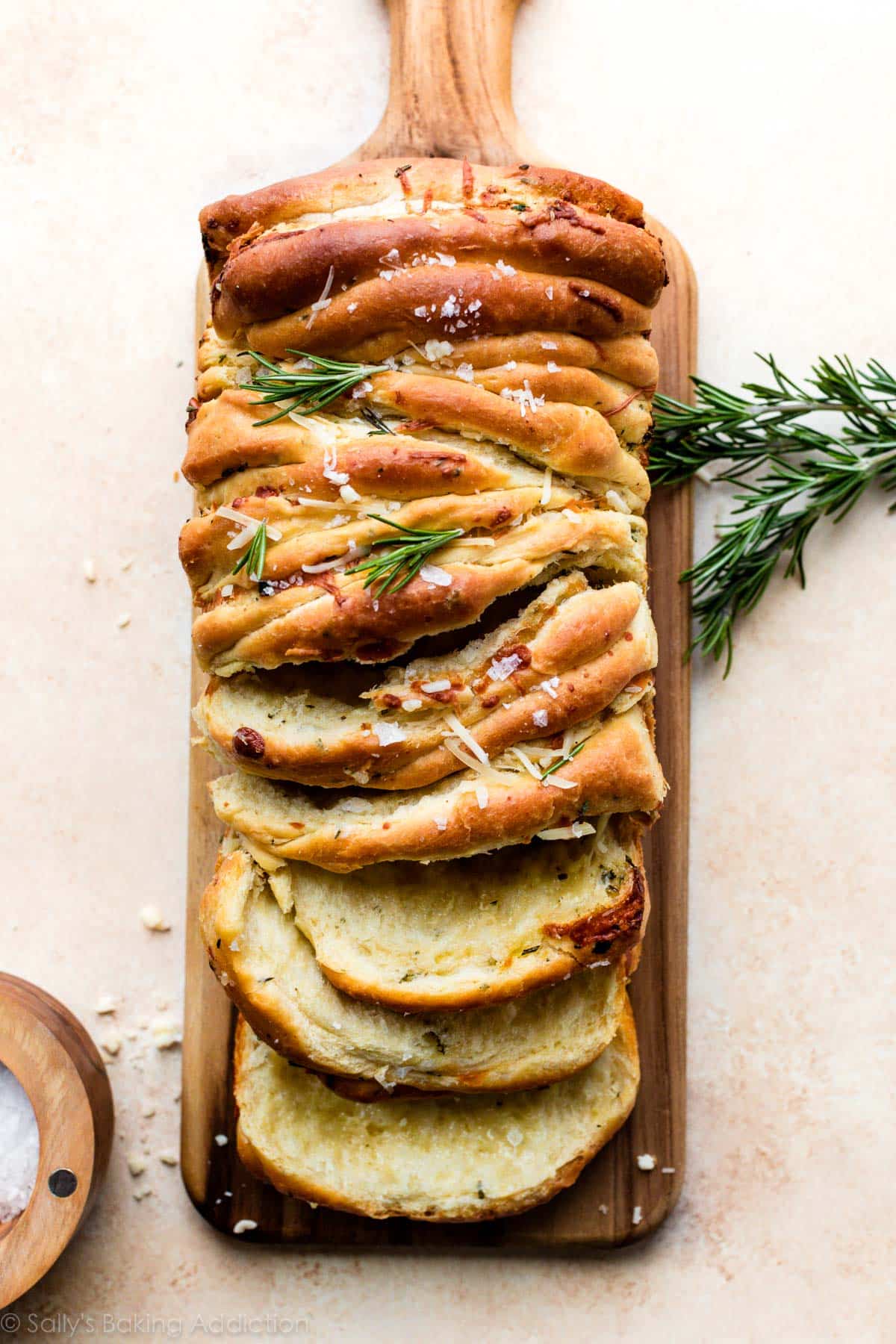
Have you ever tried my everything bagel pull apart bread? It is, without a doubt, one of the best bread recipes to come out of my kitchen. I wanted something equally as snack-y and satisfying for this holiday season, so I swapped in some everyday foolproof ingredients like rosemary, butter, and parmesan cheese.
I don’t think a finished recipe has ever disappeared faster in my house. (And I make chocolate chip cookies on the regular.)
Tell Me About This Rosemary Garlic Pull Apart Bread
- Flavor: Cheesy & garlic, rosemary & herb, salty & buttery—all packed inside the homestyle goodness of from-scratch bread. This recipe has a range of some of the BEST flavors around.
- Texture: In addition to the irresistible flavor, this pull apart bread’s texture is definitely something to write home about. The exterior is golden crisp right out of the oven, sealing in a soft and flaky center. The assembly and shape allows for many little peaks and valleys, so you have a lot more texture than, say, dinner rolls or sandwich bread. I’m happy to report that we’re almost nearing croissants in terms of flakiness. (!!)
- Ease: Many pull apart bread recipes use a loaf of bakery bread from the store and while that’s certainly easy and delicious, this recipe utilizes a 9 ingredient homemade dough. If you’ve ever been nervous to bake bread, this recipe is a great starting point. Shaping is pretty simple—the loaf can look messy going into the oven. If you’re new to baking with yeast, review my Baking with Yeast Guide. Lots of helpful information there!
- Time: There’s no arguing that homemade bread takes time, but the results are always so worth the commitment. Luckily this recipe yields 1 simple loaf and once you get the assembly process down, it moves pretty quickly. Set aside at least 4 hours from start to finish, but keep in mind most of that time is hands off as the dough rises.
Looking for rosemary & herb dinner rolls? You will love these herb skillet rolls.
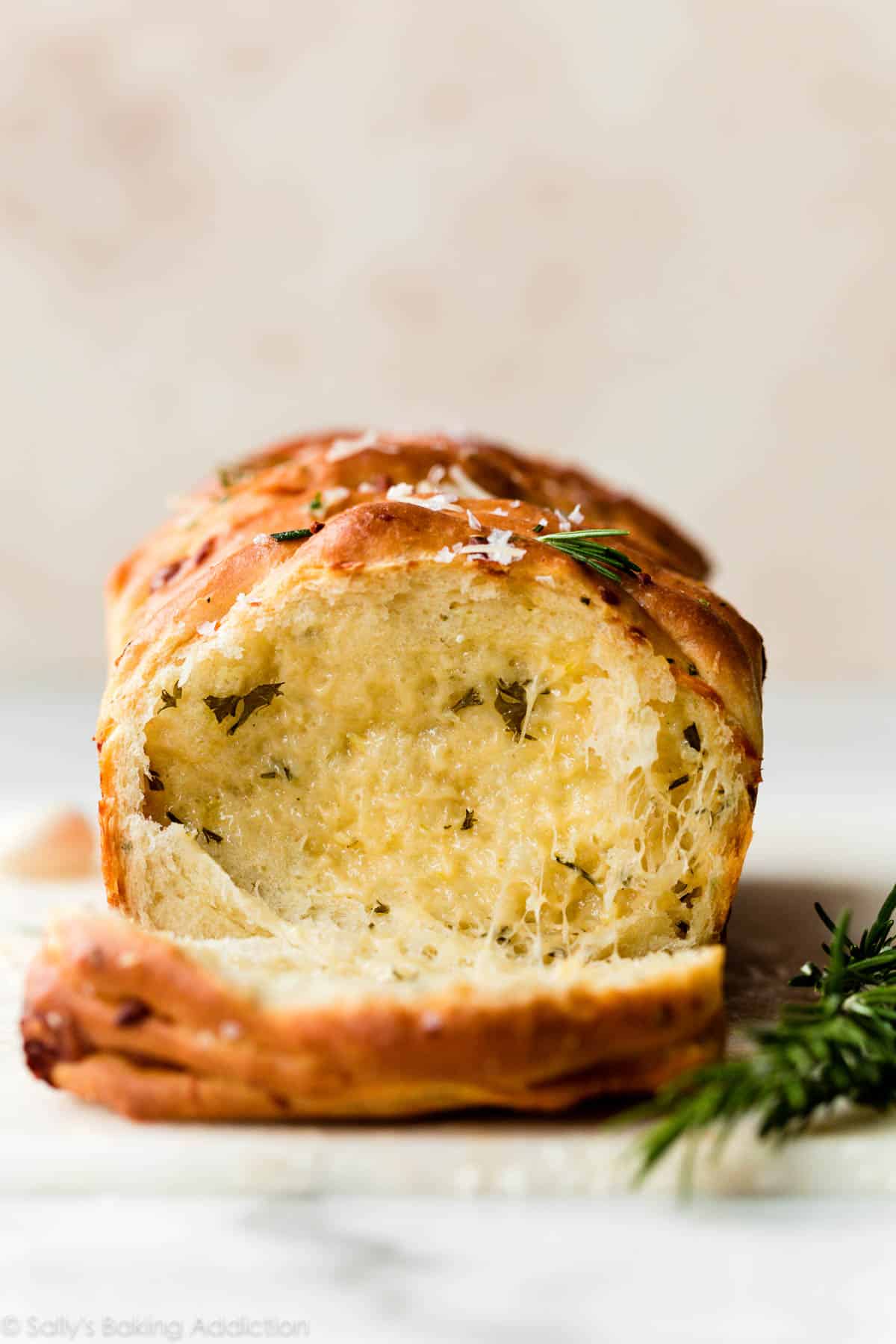
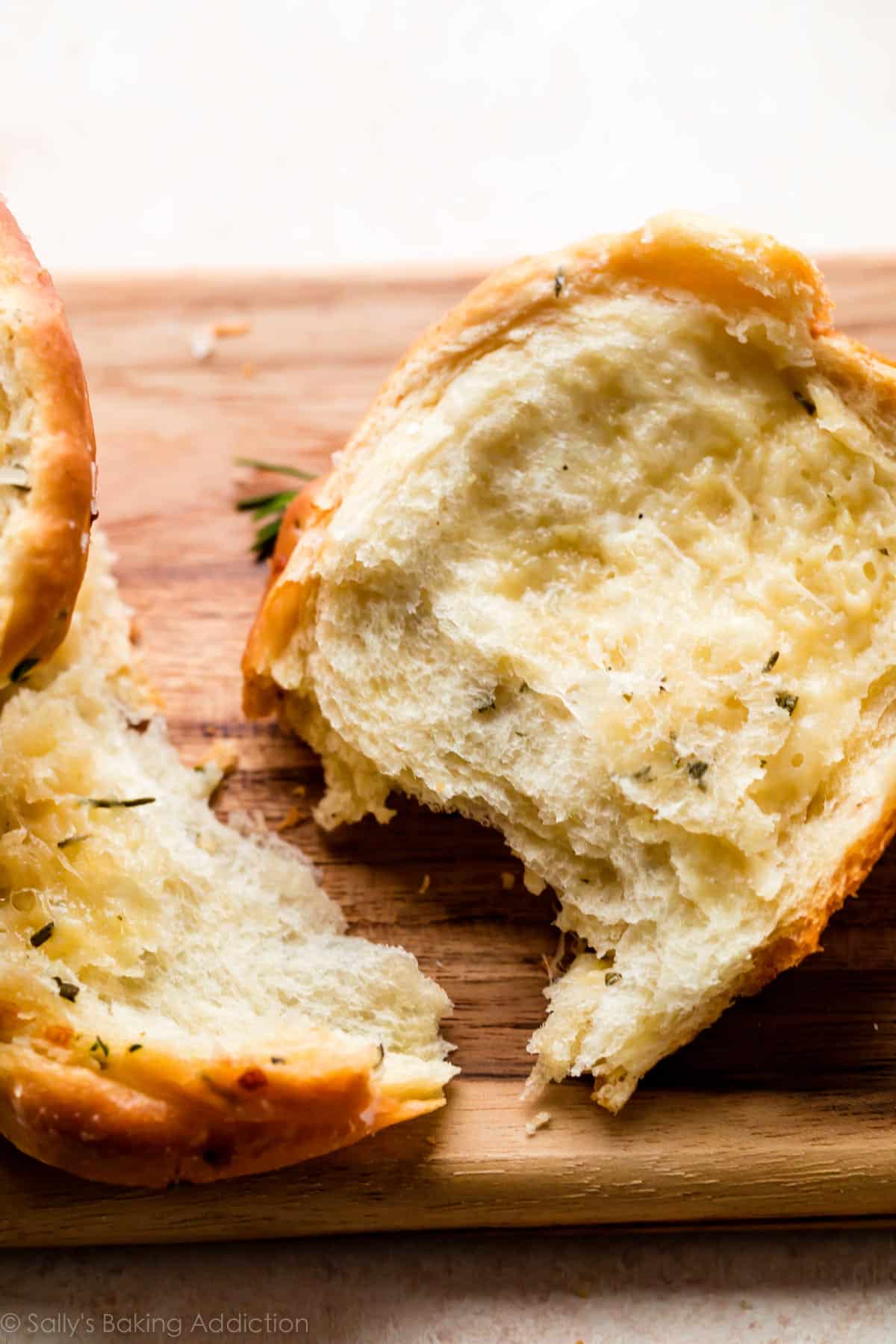
Video Tutorial: How to Make Rosemary Garlic Pull Apart Bread
Let’s Review the Pull Apart Bread Dough
I don’t want to stand in the way of you and this carb-y perfection, so I’ll try to keep this short. This pull apart bread starts with homemade dough. You need 9 simple ingredients including: yeast, sugar, milk, butter, salt, egg, flour, rosemary and garlic powder. Sugar feeds the yeast, while milk hydrates it and gives the bread a softer texture (as opposed to water). Butter, salt, rosemary, and garlic powder add flavor. Egg contributes to the rising and provides more texture and structure.
- We’re using a superior yeast: Platinum Yeast from Red Star. This is an instant yeast that strengthens the dough and provides extra volume to the final product. It’s my preferred yeast for any and all bread baking—I use it exclusively in my kitchen because it’s always a guarantee. We only need 2 teaspoons of dry yeast which is a little less than 1 standard packet.
How to Assemble Pull Apart Bread
There are a billion ways to make and assemble pull apart bread. I use a rolling pin and biscuit cutter for my everything bagel pull apart bread and while you can definitely use that same method here, I opted for something even easier today. You won’t have leftover dough scraps this way.
- Divide dough into 12 equal pieces.
- Flatten into 4-inch circles. They don’t need to be perfect.
- Spread garlic herb butter on top. Sprinkle with cheese.
- Fold the circles in half and arrange upright in a 9×5-inch loaf pan.
*You don’t need a rolling pin, but you could certainly use one if you want.
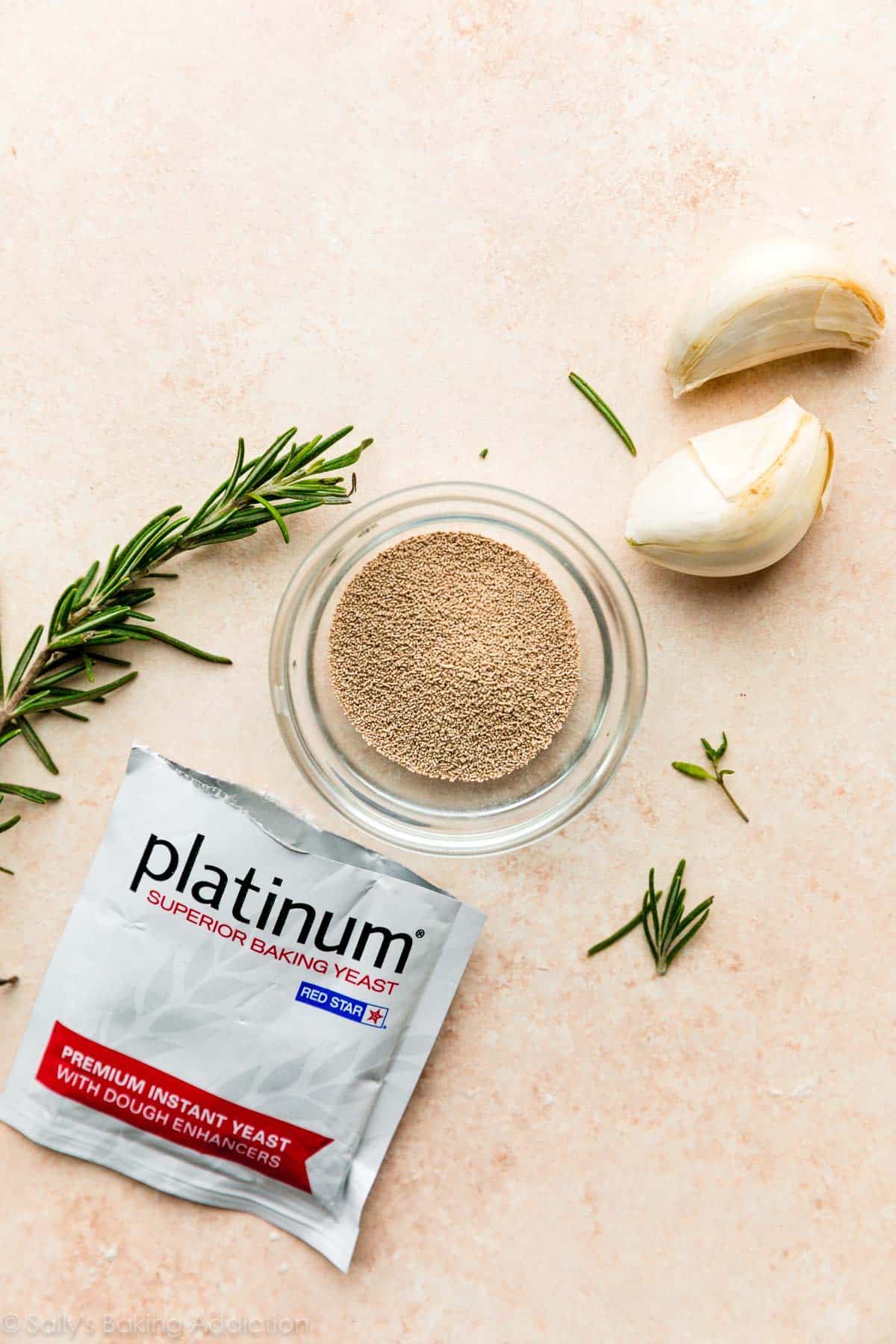
Pull Apart Bread Step by Step Photos
When you get started, use these helpful photos as your guide.
Make and knead the dough, referencing my How to Knead Dough tutorial as needed. After the dough rises, punch it down and divide into 12 pieces.
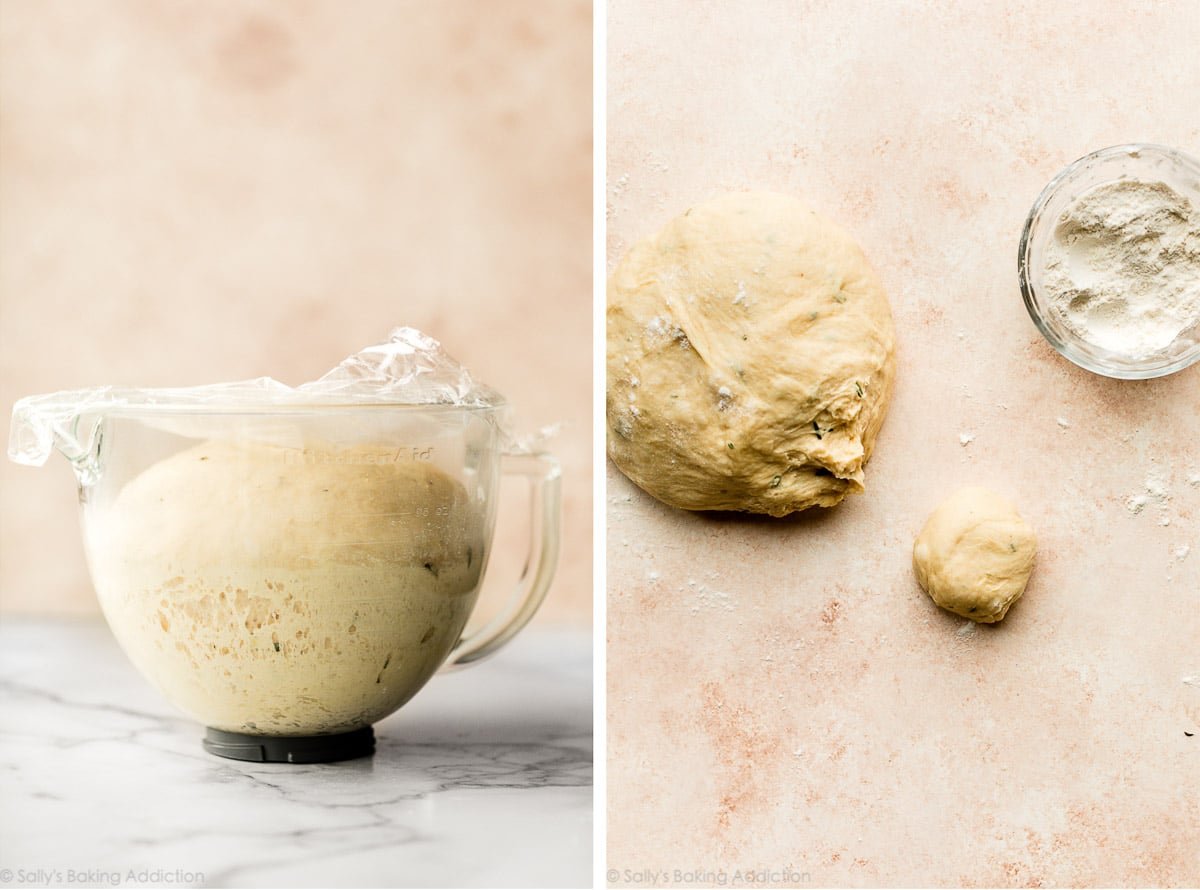
Flatten the dough rounds and spread each with garlic herb butter.
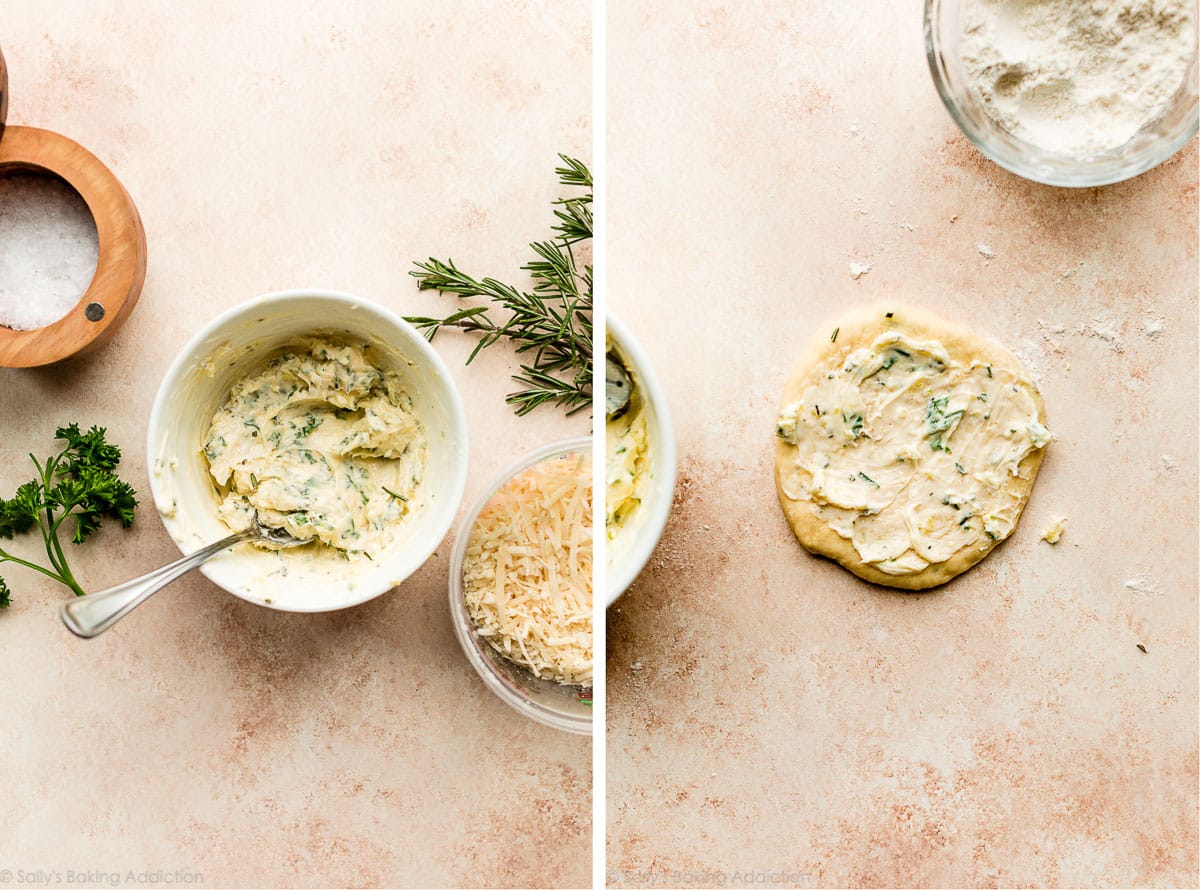
Sprinkle with cheese and fold in half to resemble a taco.
Note: I love cheesy bread, but I appreciate that it doesn’t overpower the rosemary in this recipe. If you’re looking for a heavier cheesy flavor, you will love my homemade cheese bread or asiago-crusted skillet bread.
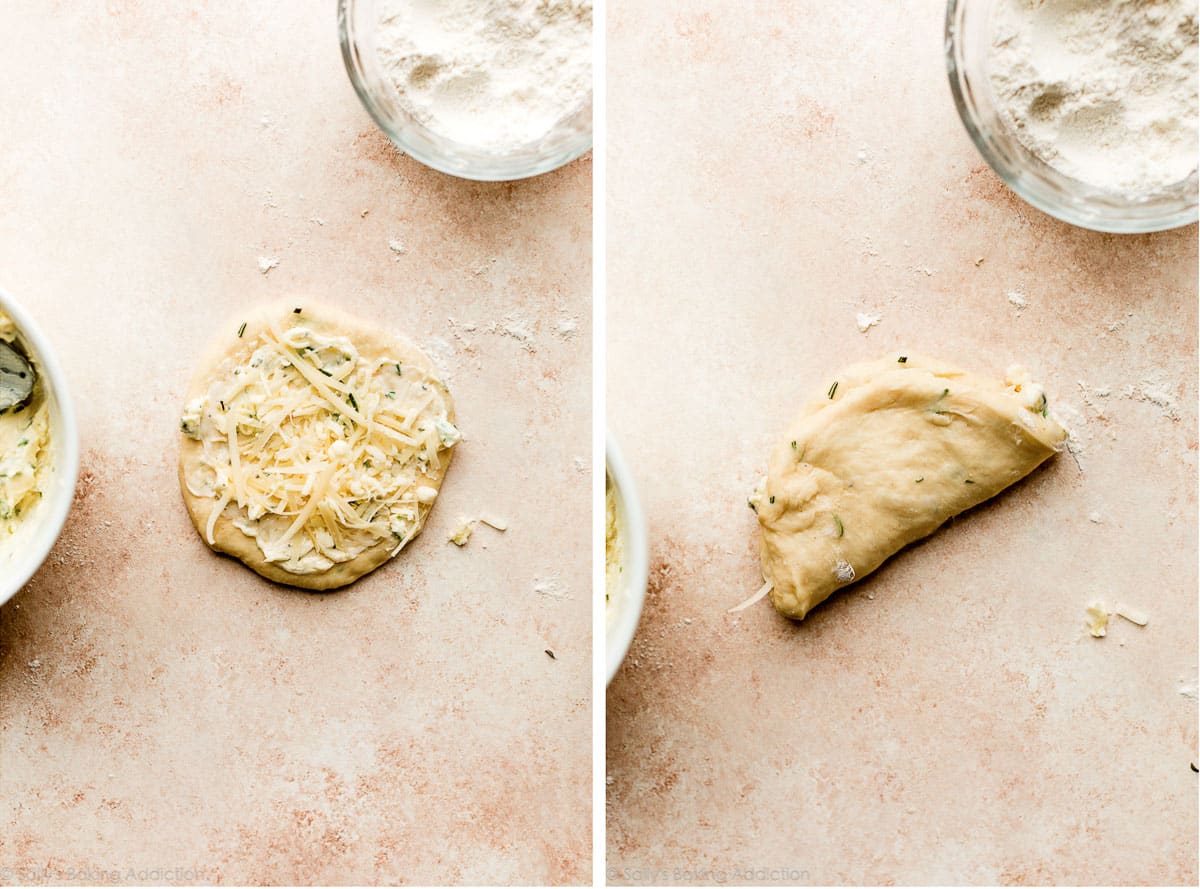
Why fold the circles in half? Folding the dough circles in half gives the bread a solid base where no butter/cheese can seep through. I had so much trouble with a similar recipe when I tried to arrange buttered squares of dough in a loaf pan. The butter leaked everywhere and the bread was a greasy mess. While some butter melts around the sides here, the bread’s base is pretty solid.
Line folded circles in a greased loaf pan.
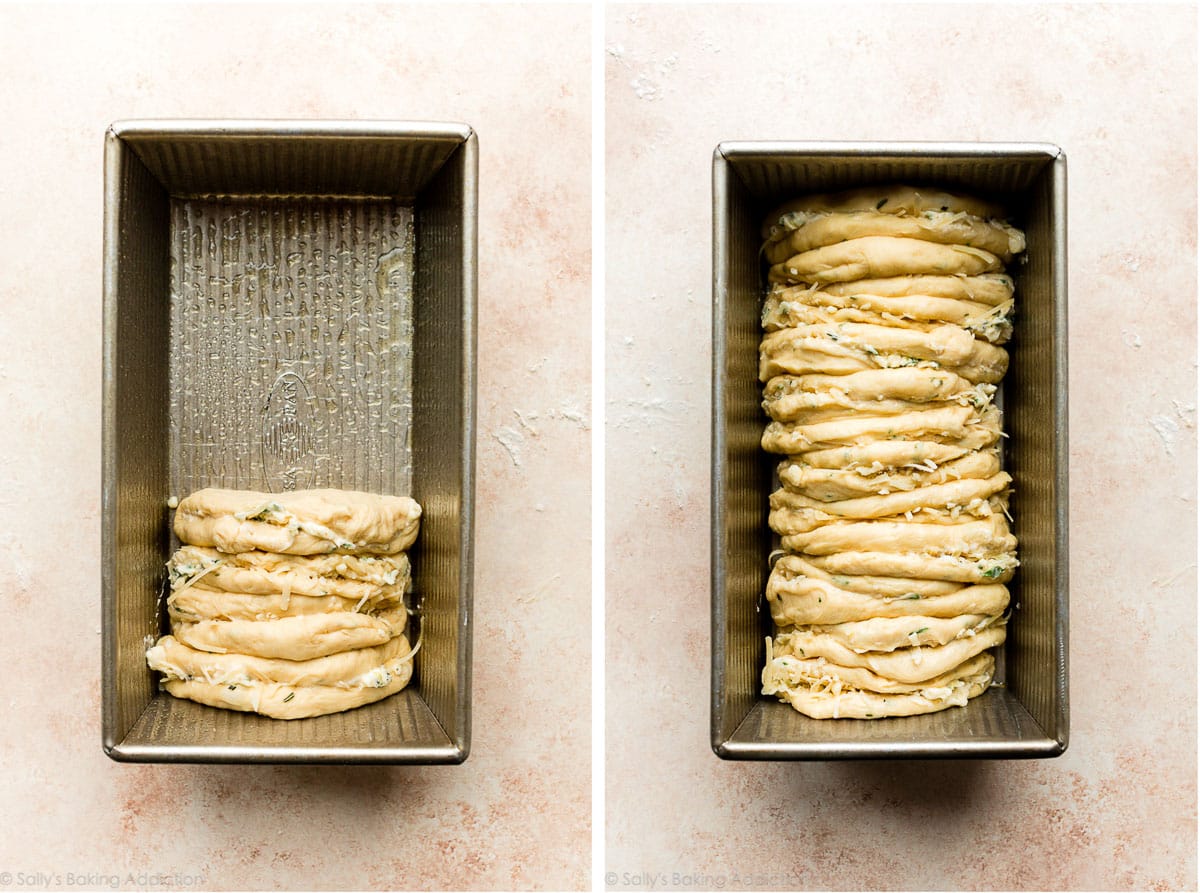
Allow to rise until puffy, then bake until golden brown.
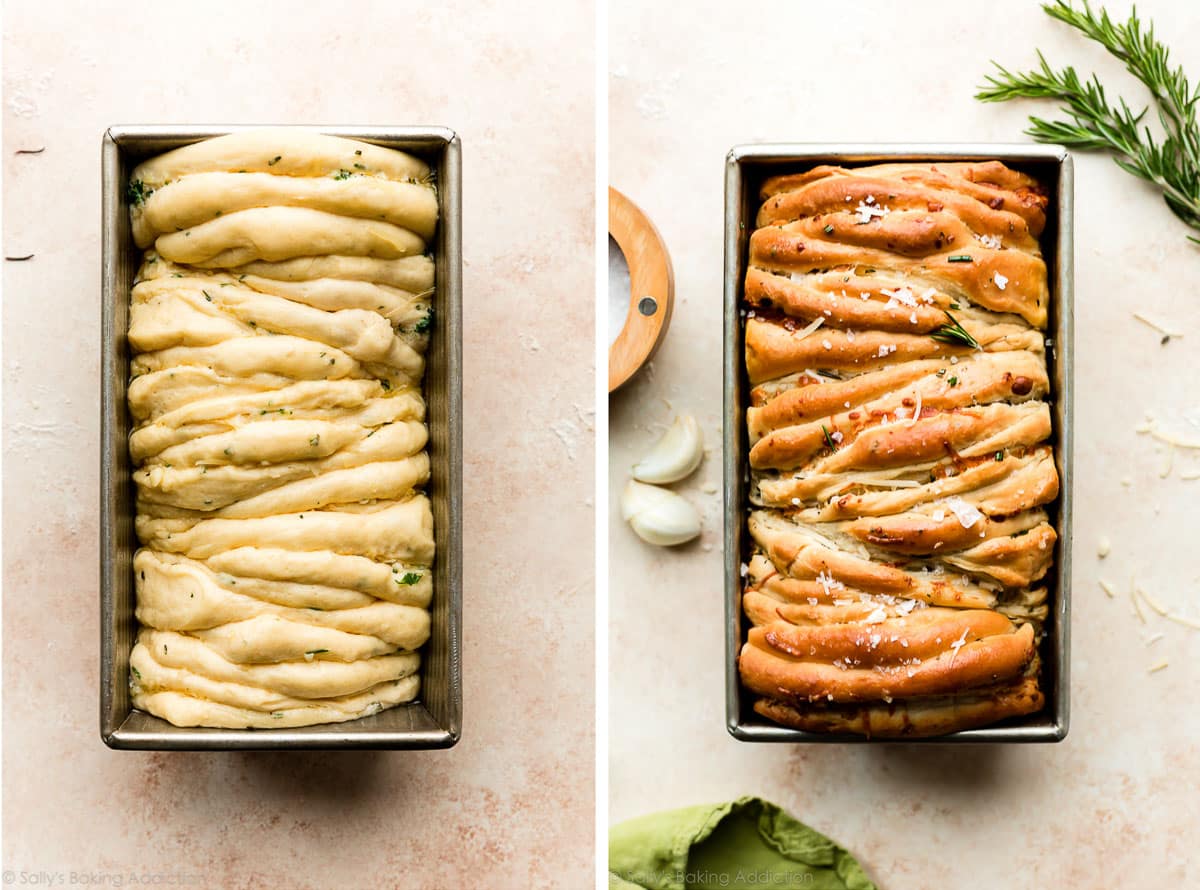
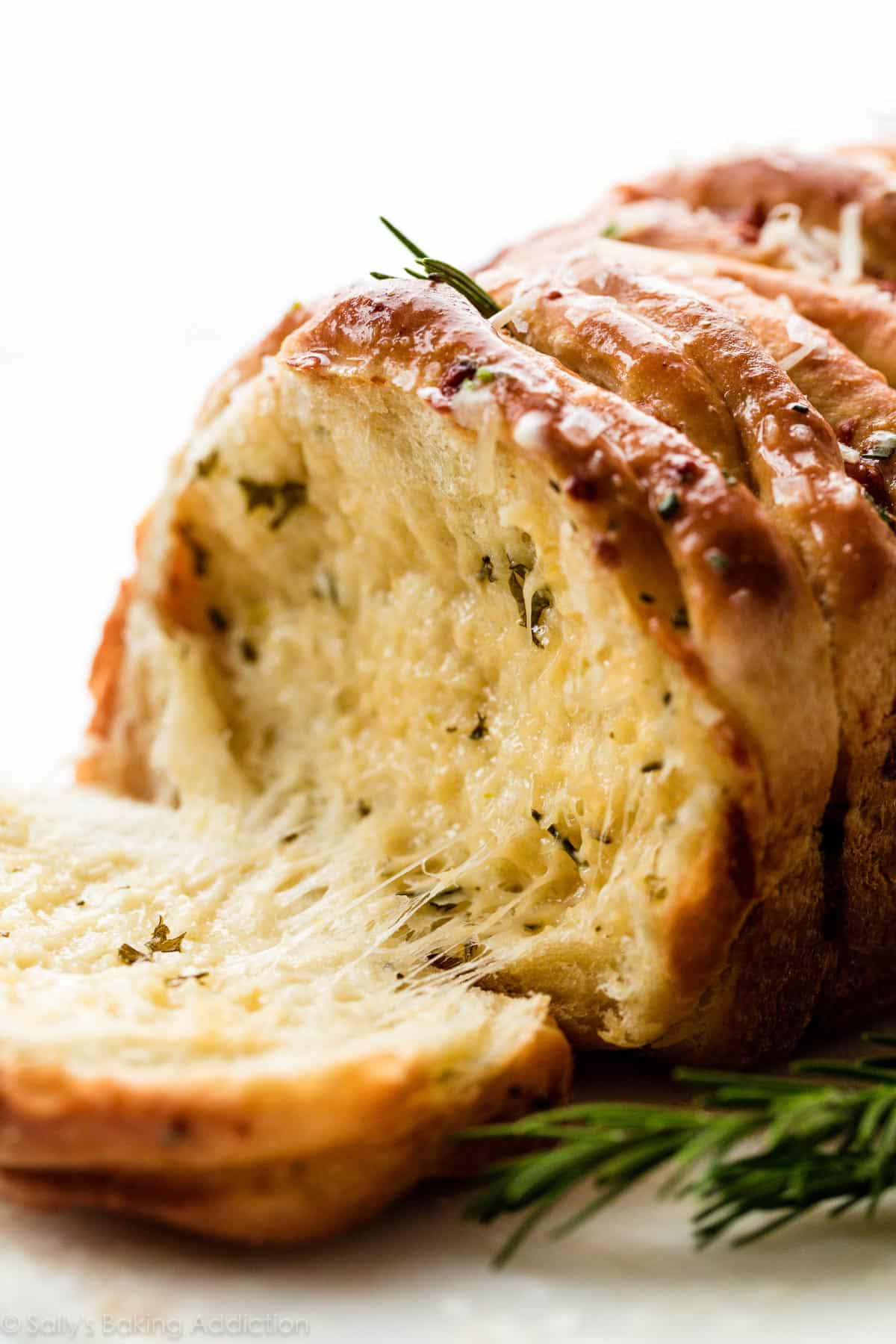
This bread fits the bill for a snack, appetizer, or alongside dinner. You can slice the loaf or tear off pieces. Whenever or however you serve it, I’m confident every lucky taste tester will beg for seconds. If you love the garlic and herb butter flavors in this recipe, try these pizza pull apart rolls next. And if you’re craving sugar, this homemade monkey bread is equally mouthwatering and perfectly acceptable for breakfast. 😉
Print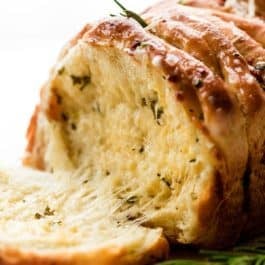
Rosemary Garlic Pull Apart Bread
- Prep Time: 3 hours
- Cook Time: 50 minutes
- Total Time: 4 hours
- Yield: 1 loaf
- Category: Bread
- Method: Baking
- Cuisine: American
Description
Make a flavorful pull apart bread using this delicious rosemary-infused yeasted dough. You can use your favorite cheese in the filling. I love and usually use shredded parmesan.
Ingredients
Dough
- 2 teaspoons Platinum Yeast from Red Star*
- 1 Tablespoon granulated sugar
- 3/4 cup (180ml) whole milk
- 3 Tablespoons (43g) unsalted butter, softened to room temperature
- 1 large egg
- 2 and 1/3 cups (291g) all-purpose flour (spooned & leveled), plus more as needed*
- 1 teaspoon salt
- 1 teaspoon garlic powder
- 1 Tablespoon finely chopped fresh rosemary (or 2 teaspoons dried)
Filling
- 5 Tablespoons (71g) unsalted butter, extra soft (see note)
- 1 Tablespoon finely chopped fresh rosemary (or 2 teaspoons dried)
- 1 Tablespoon finely chopped fresh parsley (or 2 teaspoons dried)
- 2 garlic cloves, minced or 1/2 teaspoon garlic powder
- 1/4 teaspoon salt
- 3/4 cup (95g) shredded parmesan, mozzarella, or white cheddar cheese (or your favorite shredded cheese)
Optional Topping
- 1 Tablespoon (14g) unsalted butter, melted
- coarse or flaky sea salt for sprinkling
Instructions
- Make the dough: Place the yeast and sugar in the bowl of a stand mixer fitted with a dough hook or paddle attachment. Or, if you do not own a stand mixer, a regular large mixing bowl. Heat the milk on the stove or in the microwave until warm to touch, about 110°F (43°C). Pour warm milk on top of yeast/sugar. Whisk gently to combine, then loosely cover with a clean kitchen towel and allow to sit for 5-10 minutes. The mixture will be frothy after 5-10 minutes.
- If you do not have a mixer, you can mix the dough together with a wooden spoon or silicone spatula in this step. Add the butter, egg, flour, salt, garlic powder, and rosemary. Beat on low speed until the dough comes together and pulls away from the sides of the bowl, about 3 minutes. If the dough isn’t pulling away from the sides of the bowl, add a little more flour, a Tablespoon at a time. Dough will be soft.
- Knead the dough: Keep the dough in the mixer (and switch to the dough hook if using the paddle) and beat for an additional 5 full minutes, or knead by hand on a lightly floured surface for 5 full minutes. (If you’re new to bread-baking, my How to Knead Dough video tutorial can help here.) If the dough becomes too sticky during the kneading process, sprinkle 1 Tablespoon of flour at a time on the dough or on the work surface/in the bowl to make a soft, slightly tacky dough. Do not add more flour than you need because you do not want a dry dough. After kneading, the dough should still feel a little soft. Poke it with your finger—if it slowly bounces back, your dough is ready to rise. You can also do a “windowpane test” to see if your dough has been kneaded long enough: tear off a small (roughly golfball-size) piece of dough and gently stretch it out until it’s thin enough for light to pass through it. Hold it up to a window or light. Does light pass through the stretched dough without the dough tearing first? If so, your dough has been kneaded long enough and is ready to rise. If not, keep kneading until it passes the windowpane test.
- 1st Rise: Shape the kneaded dough into a ball. Place the dough in a greased bowl (I use nonstick spray to grease) and cover with plastic wrap or aluminum foil. Place in a slightly warm environment to rise until doubled in size, around 60-90 minutes. (If desired, use my warm oven trick for rising. See my answer to Where Should Dough Rise? in my Baking with Yeast Guide.)
- As the dough rises, prepare the filling in the next step and grease a 9×5-inch loaf pan.
- Make the filling: In a medium bowl, mix the soft butter, rosemary, parsley, garlic, and salt together. If the butter is soft enough, you can just mix it all together with a spoon or fork. You can use an electric mixer if that’s easier too. Cover tightly and set aside until ready to use. (Don’t refrigerate unless making well in advance. It’s easiest to spread on the dough when at room temperature. If refrigerated, let it come to room temperature before spreading on dough pieces.)
- Assemble the bread: Punch down the dough to release the air. Place dough on a lightly floured work surface. Divide it into 12 equal pieces, each about 1/4 cup of dough and a little larger than a golf ball. Using lightly floured hands, flatten each into a circle that’s about 4 inches in diameter. The circle doesn’t have to be perfectly round. I do not use a rolling pan to flatten, but you certainly can if you want. Spread 1-2 teaspoons of filling mixture onto each. Sprinkle each with 1 Tablespoon of cheese. Fold circles in half and line in prepared baking pan, round side up. See photos above for a visual.
- 2nd Rise: Cover with plastic wrap or aluminum foil and allow to rise once again in a slightly warm environment until puffy, about 45 minutes.
- Adjust the oven rack to the lower third position then preheat oven to 350°F (177°C).
- Bake until golden brown, about 50 minutes. If you find the top of the loaf is browning too quickly, tent with aluminum foil. (Don’t be alarmed if there’s melted butter around the sides of the bread as it bakes, it will seep into the bread before it finishes.) Remove from the oven and place the pan on a wire rack. If desired, brush with melted butter for topping and sprinkle with sea salt.
- Cool for 10 minutes in the pan, then remove from the pan and serve warm.
- Cover and store leftovers at room temperature for up to 2 days or in the refrigerator for up to 1 week. Since the bread is extra crispy on the exterior, it will become a little hard after day 1. Reheat in a 300°F (149°C) oven for 10-15 minutes until interior is soft again or warm in the microwave.
Notes
- Make Ahead Instructions: Freeze baked and cooled bread for up to 3 months. Thaw at room temperature or overnight in the refrigerator and warm in the oven to your liking. The dough can be prepared through step 4, then after it has risen, punch it down to release the air, cover it tightly, then place in the refrigerator for up to 2 days. Continue with step 5. To freeze the dough, prepare it through step 4. After it has risen, punch it down to release the air. Wrap in plastic wrap and place in a freezer-friendly container for up to 3 months. When ready to use, thaw the dough overnight in the refrigerator. Then let the dough sit at room temperature for about 30 minutes before continuing with step 5. (You may need to punch it down again if it has some air bubbles.)
- Special Tools (affiliate links): Electric Stand Mixer or Large Glass Mixing Bowl with Wooden Spoon / Silicone Spatula | 9×5-inch Loaf Pan | Cooling Rack | Flaky Sea Salt
- Yeast: I always use Platinum Yeast from Red Star, an instant yeast. If using active dry yeast, the rise times could be slightly longer. Reference my Baking with Yeast Guide for answers to common yeast FAQs.
- Flour: Feel free to use the same amount of bread flour instead of all-purpose flour. You can also try swapping out 1 cup of flour for whole wheat flour. Do not replace all of the flour with whole wheat flour—just 1 cup.
- Extra Soft Butter for Filling: Have you ever read my page about room temperature butter? Room temperature butter for baking should still be cool to the touch. You want room temperature butter for the dough. However, for the filling, you want extra soft butter so you can easily spread it onto the flattened dough without tearing the dough. Feel free to microwave it for 10-15 seconds to help it get extra soft.
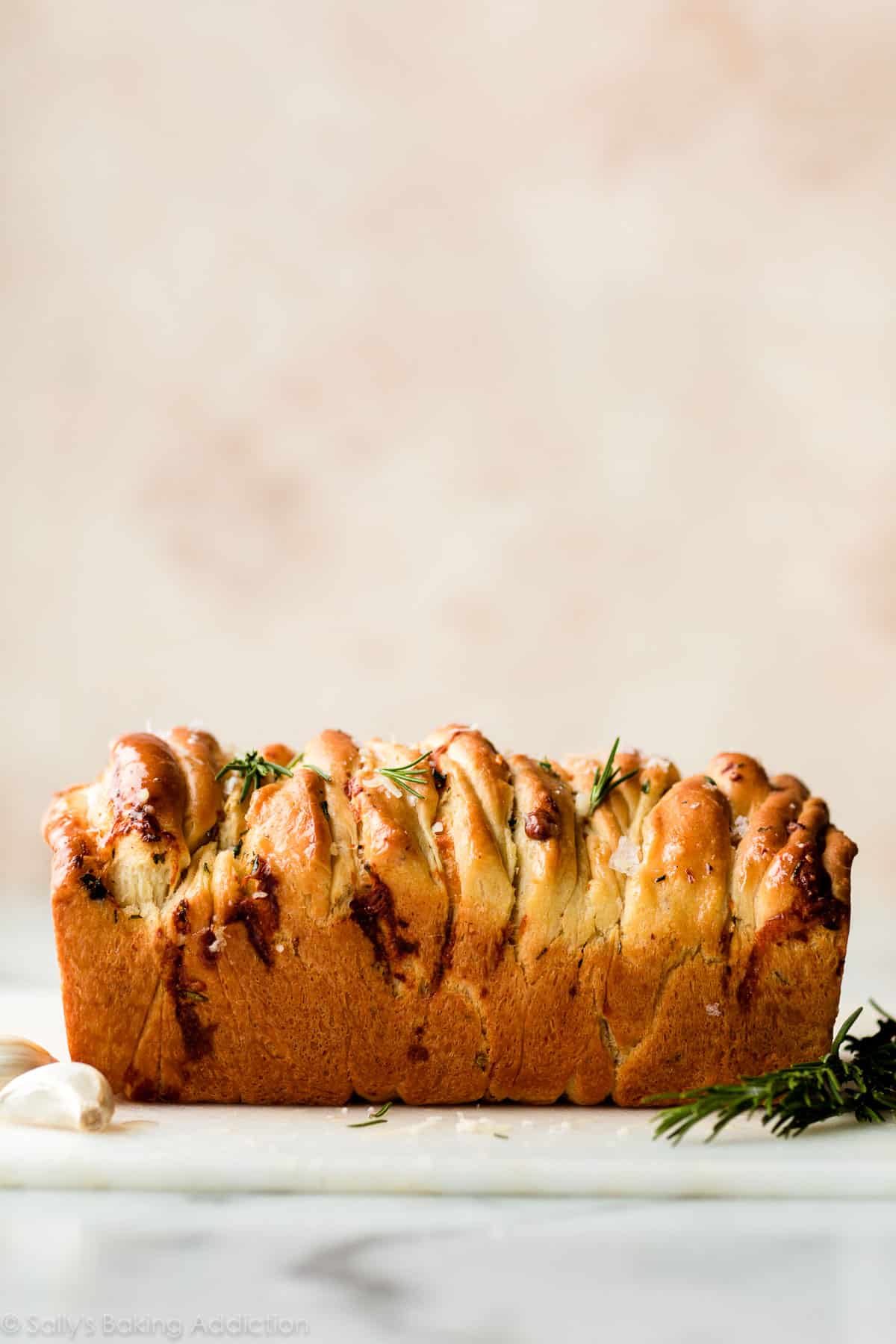





















You should make a garlic cheese bread recipe.
Hi Wesley, you might love these Cheesy Breadsticks made with a butter, garlic, herb seasoning, and topped with lots of mozzarella cheese. Let us know if you give them a try!
can you make this without the cheese?
Hi Vandana, yes, you can omit the cheese.
I love your website and use it all the time. But the pop ads on this recipe were so bad I had to reload the recipe over and over again because they wouldn’t close. I’m troubleshooting something and the next thing I know an add is blocking the recipe and I have to wait forever for it to close, if it closes at all. Then when it doesn’t, I have to reload the page and scroll to what I was trying to read to have the ad pop up again. It may deter me from continuing to use your site.
Hi Samantha, I have actually been having the same problem, and we have already contacted our ad network to get this fixed. They’re working on it now. Sorry for the inconvenience, I know it’s annoying!
This was so yummy! I think next time I’ll make extra butter filling as a personal preference. But this was so flavorful, and the bread was really light and fluffy! And I really appreciate the metric measurements, as I just moved from the US to Norway, so not having to convert ingredient amounts is very helpful when I’m shopping. The tips for kneading were very useful as well! We only have salted butter here, so I reduced the salt in the dough a little bit. And the note about active dry yeast vs. instant – all we have available is active dry, and the rise times were spot on with the recipe. I will definitely be making this bread again!
So glad this recipe was a hit for you, Lynne, and that you found our conversions helpful!
I really wanted to love this recipe. I always weigh everything out because it’s less chance for me to mess it up but the weighed measurements here are not even close to being correct. Following them exactly I was given a very very wet dough that no amount of kneading was going to bring together. I had to add so much more flour to get it to come together properly and by then it was horribly overkneaded and had to be tossed. I love this website and recipes. I wish I had read the comments beforehand to know that the weighed measurements here are not correct.
Hi Sara, I’m so sorry to hear this recipe didn’t turn out well for you. We will revisit testing this recipe to see if it needs updating. Thank you for trying this recipe!
I had the exact same problem :0 I actually tried baking this bread today and since I’m new to baking bread, I also weighted everything to make sure I had everything correct. I had to knead for a long while and had to add flour many times because the dough was very very wet… It took a lot more time than expected and I thought I was doing something wrong… HOWEVER ! The final result was VERY tasty and my boyfriend and I LOVED it !! Also, small differences: I used thyme instead of rosemary since that’s what I had at home and I also mixed the shredded cheese directly into the butter and herb mix (I read the instructions too quickly lol). Overall great recipe and I would do it again for guests, but the kneading was kinda messy.
So delicious that I ate 1/3 of the loaf in one sitting!
This recipe was super fun to make and delicious too.
I just made it for company as a side to spaghetti and meatballs. It is absolutely amazingly delicious. Thank you!
This recipe is wonderful! I subbed in oat milk and instead of an egg used baking soda and distilled vinegar, and it still came out great. Plus, since I’ve recently begun moving and realized too late that my loaf pan was at my old apartment, I used my cast iron skillet and hoped for the best. It still came out beautiful. I will be using this recipe again!
What if I forgot the eggs? Will it affect the recipe?
This is the yummiest and easiest bread!!! So soft and fluffy and so delicious!!!!
I am not kidding. Every recipe I have ever made of yours has never failed me. Sally u are a great cook
Hello, thank you for this great recipe. Would using Almond Milk instead of whole alter the taste significantly? Thank you.
Hi Mariam, you can use almond milk if needed. The bread may not be quite as soft. We hope you enjoy it!
Great recipe! Fun and worked out well. Vegan substitutions I made:
1/4 cup aquafaba for egg
Violife salted butter
Oatly oat milk for milk
Follow your heart parmesan
I found the dough a bit overhydrated to work after the substitutions, so I just worked in more flour as the recipe suggested. worked like a charm!